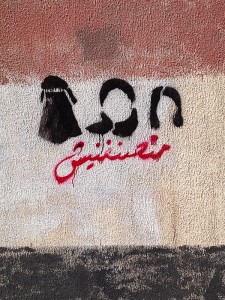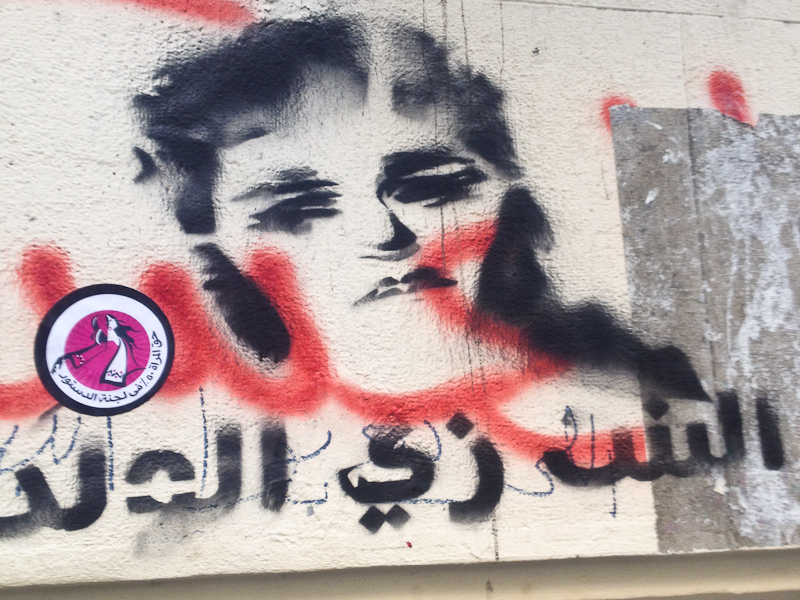Only the clock stymies Merna Thomas’ passion for her work.
Thomas, the founder of NooNeswa, was speaking as part of a panel about art for social change. The moderator gently reminded the young Egyptian woman that there was still one other person who needs to speak, Thomas’ time was up.
The discussion was part of a larger one, a weekend-long international development conference for youth that ran Nov. 1–3 in Ottawa. It was put on by the World University Service of Canada (WUSC) and university students came from across the country to engage in development issues.
On Nov. 3, part of the discussion revolved around art and how it can be used to challenge world views and social norms.
Just over a year ago, Thomas started NooNeswa, a feminist campaign in Egypt that tackles negative images and stereotypes about women through graffiti.
Egypt’s walls are already covered in “macho” graffiti, Thomas says, so her campaign isn’t destroying Cairo’s walls so much as enlightening them.
“Women are not a minority, they’re half the population,” she explained.
Thomas said she doesn’t want the work misconstrued as simply art.
“It’s more like graffiti activism than graffiti art,” she said.
The graffiti is rather simple, but its message gets across. One image shows the outline of three women: one wearing a headscarf, another with long, loose hair and another with her hair tied back. Other graffiti uses iconic Egyptian images, but with a feminist twist.
 “The idea behind the campaign was when we first started we thought that the more effective way to reach the street was not to attack, [there were] already many negative sources around women . . . we wanted to help people relate. That’s what sticks,” Thomas said.
“The idea behind the campaign was when we first started we thought that the more effective way to reach the street was not to attack, [there were] already many negative sources around women . . . we wanted to help people relate. That’s what sticks,” Thomas said.
And while her group has support from both men and women, not everyone agrees.
Thomas showed the room of university students in Ottawa a video of a man getting angry with members of NooNeswa as they spray-painted their message.
Thomas explained that the best tactic is to ignore and to deflect, since in Egypt it’s very easy for one debate to turn into an argument. This becomes physical and eventually an all-out riot.
Addressing stereotypes and negative images is something Thomas and NooNeswa have been trying to do for more than a year. One of NooNeswa’s campaigns was launched on International Women’s Day in 2012.
Only a year earlier, on March 9, 2011, at least 18 female protestors in Cairo’s Tahrir Square were taken into custody where most were detained for four days and beaten, subjected to strip searches and forced to undergo invasive “virginity tests,” according to Amnesty International.
Since then, Amnesty says violence against female protestors has been present in most public demonstrations in Egypt.
“If a woman protestor got attacked or subjected to a virginity test . . . the public opinion would just blame her,” Thomas said.
She said part of the problem is current Islamic political discourse. Post-revolution is all about limiting women, she said.
“Women were told not to be in the streets anymore,” she said. “They were being blamed for being in the streets.”
Despite her criticism of political discourse, Thomas says most of NooNeswa’s funding comes from the Egyptian government, although she’s quick to add, “it’s cheap to make graffiti in Cairo,” unlike in Canada, she said.
The group is also partially funded by women’s organizations in the region—groups that Thomas said have budgets already in place for art initiatives.
As NooNeswa continues to plaster Cairo with women-friendly images and messages, Thomas said the goal will be figuring out how to make NooNeswa self-sustainable.
It’s a theme that fits with most of the smaller discussions happening at the WUSC conference: different messages, different goals but still the same question of how to engage, how to sustain.






